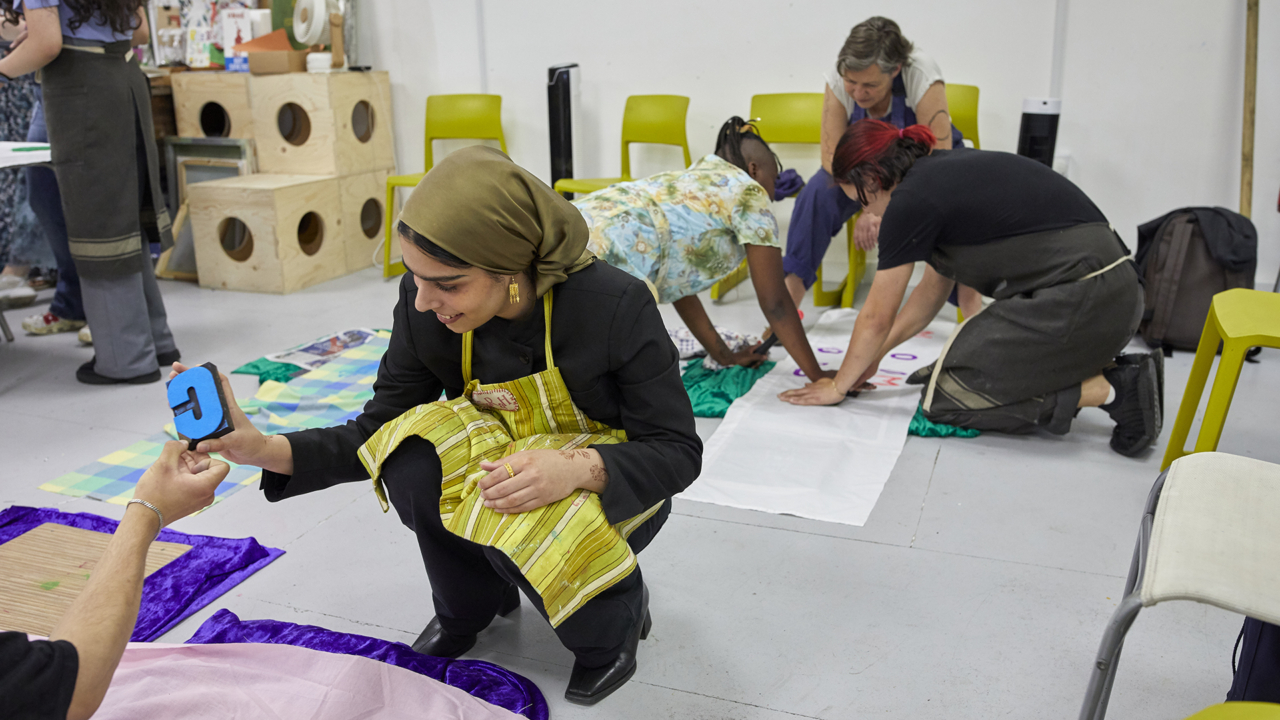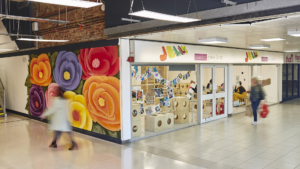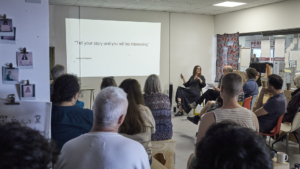- Posted on November 11th, 2024
Jelly – Embedding Sustainability in the Arts

This story of action, one of nine in depth case studies featured in Arts Council England and Julie’s Bicycle’s Environmental Programme Annual Report 2023-24, was written by Jelly. The Report features over 50 practical examples of cultural organisations taking climate action. Check out the full interactive report here.
Jelly are an arts charity based in Reading, who support and develop visual artists, building pathways towards careers in the creative industries and providing freelance opportunities. They share how they have embedded sustainability across everything they do, from artist project spaces to community workshops, despite the challenges of being a nomadic organisation in temporary spaces with little resources.
About Jelly
This is Jelly’s first year as a national portfolio organisation (NPO) and it has felt quite a leap as we are a small organisation. We are a nomadic organisation that takes on empty spaces so some things are out of our control, but we have always had a policy of working with what we have.
We are an organisation that considers our materials and makes the most of what is available. Initially this started from sharing our own materials and developed into ideas for making art using other people’s junk. In 2019, we reviewed all the materials and decided to ban some unsustainable products from our workshop. We also began to develop ideas with artists to support them to create their work in low impact ways. This has been a big learning journey for all of us. As an organisation, we are embedded in the community, working largely with those that have limited access to materials – we want to support them using everyday materials that are kind to the planet. It is a good way to explore these ideas together. Sustainability is deeply embedded within our values.
Adapting Space with Limited Control and Sustainability in Mind
Over the past 30 years, we have occupied 28 different spaces at various times. The spaces have varied in size and were usually short term lets, where we adapted what we do to fit the space. Our current space is in a shopping centre built in the 70s, in a poorly fitted out shop unit. This was the only space we could afford but it offered great potential for artists’ spaces. We wanted to make it practical and accessible to all.

We applied for funding to create self-build artists studios, with the help of U Build. We created permanent but demountable pods using their sustainably built boxes that can be reconstructed. When we were planning the pods, we were offered one at a reduced cost that had previously been used and was no longer needed, so we were delighted to be able to rehome one that had already been built; part of our reuse philosophy and trying not to create more new things. The pods help the space feel welcoming despite being restricted financially in what we can do and the limitations of an old building. We have learnt various skills from our years of being nomadic and we apply them to each space.
For example, this space had an issue where there was no water being served into it. We originally discussed the possibilities of putting in the plumbing but we also realised that we had access to a back room for the shop tenants where we can get water. It is not wholly convenient but it also made sense for us to use this as part of our story. Water usage and making people aware of the implications of over consumption has been a part of our thought process. With this in mind, we opted out of getting water into the space and focused on the ‘fluidity and mobility as an organisation’ – we can buy a mobile sink (once) that we can take with us and also effectively measure the amount of water we use. The mobile sink has clear 25 litre carriers, one for clean water and one for waste. The clear aspect meant that this worked as a visual aid on how the water is used. Initially some people were apprehensive about the idea, that it might be tricky but everyone has quickly adapted to it. This has definitely had an impact on water usage.

In our space we also changed all of the lighting to LED from the 1970s shopping centre’s standard issue, changed to 100% green energy and opted for a smart meter. In this past year, we secured some funding to enable us to buy low impact infrared heaters to keep the community warm. We ask for help from people who have worked with us and this was based on the advice of the architects from U Build. Even though we have relatively low control, we have the ability to manage our own space.
The space is in a brilliant location with a very diverse audience and is easily accessible. We have great window frontage and can engage with the community easily. We want to create a space where we can have these conversations with people. In our everyday work, this can be so simple – from just serving only plant-based refreshments and explaining why, to being clear about the usage and impacts in what we do.

Creating Networks and Community Work
Alongside our day-to-day work, we have set up a sustainability forum with one of our peer organisations that all arts and heritage organisations in the area are welcome to join. This peer-to-peer sustainability forum allows us to share knowledge and support other arts-based groups to develop ideas. We meet every other month, one organisation presents their current story and we give feedback, offer suggestions and support and learn from them too. This has been very useful for sharing ideas, resources and is a compassionate way to learn from each other. We talk about this work with the communities that we work with.
We also have a sustainable print room which other groups use and people donate materials to us. It is a conversation point across our creative community. Our artists residency programme application form has a question about sustainability in relation to their practice, and we offer them support with this work. We also programme conversations, including recently a panel discussion with a young curator Eleni Doulgeraki around the impact of art, in discussion with guest artists around socially engaged and sustainable art practices.
During our summer arts festival, the theme was Impact. ‘How does art impact you, our town, our spaces?’. We used this as a starting point for four artists working in a school, making art with found materials that were all recycled at the end of the creation. At the end of the project the artwork only existed in a film that was made. This has become so embedded within our values that we act in this way naturally.
“My involvement with Jelly has been in different capacities over the years, but in whatever form that has taken, the way that sustainability is deeply embedded not only in Jelly’s values but throughout its practices has inspired and supported me.
As an artist Jelly offered me resources and encouragement to explore sustainability within my own arts practice, and to think creatively about how I can be kinder to the planet.
Thanks to Jelly becoming a National Portfolio Organisation, I am now part of the core team and it’s really rewarding to be part of a charity that never just takes the easy option, but sticks to its values. Making the changes we need to make for our planet are not necessarily going to be the most convenient, or the quickest option – so whether we’re cycling bikes to deliver a workshop, measuring out jugs of water or turning waste into paper we can print on, these small actions add up, and they start important conversations.”
– Laura de Moxom, Artist
Header image: Open for Art – Jelly – Credits: John Angerson; Jelly.
